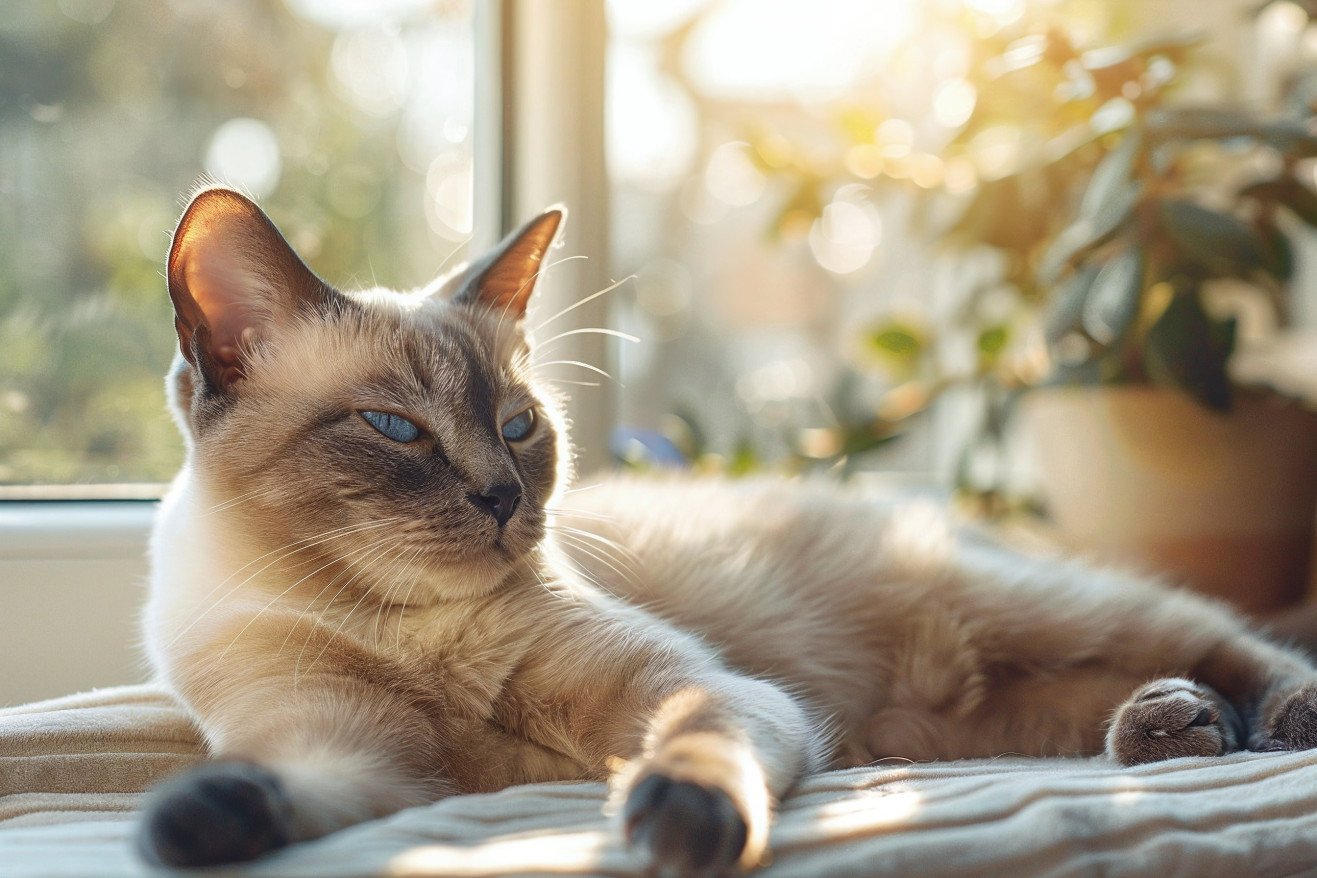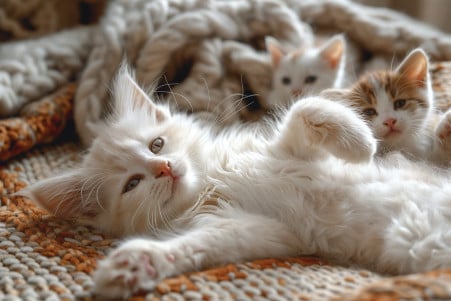Why Do Male Cats Have Nipples? A Look at Feline Anatomy
29 February 2024 • Updated 29 February 2024

Have you ever been surprised to find nipples while petting your male cat? It turns out that male cats do have nipples. Just like all other mammals, male cats grow nipples in the womb, and they stick around for the rest of their lives. However, these nipples are completely useless since male cats don’t have the mammary glands needed to produce milk.
To better understand how and why male cats have nipples, this article will take an interdisciplinary approach, drawing on research from veterinary science, evolutionary biology, and genetics. We will look at the developmental processes that lead to male cats having nipples, the hormones that play a role in whether or not they have them, and the evolutionary factors that may explain why they have them at all.
By the end of the article, we hope to have given you a more comprehensive understanding of feline biology and the mystery of male cat nipples.
Why do male cats have nipples?
What’s the Deal With Male Cat Nipples?
Male cat nipples are small, individual body parts that can be easy to miss against the backdrop of fur and skin. As Catster describes, they look the same as the nipples of a non-pregnant female cat, which means they are small, round bumps that are the same color as the cat’s skin.
Male cats typically have six to eight nipples that are evenly spaced in two rows along their belly from their chest to their groin.
Because they stick out from the skin, male cat nipples can be mistaken for things like ticks, even though they are harmless. As Great Pet Care warns, it’s important to know what they are so that you don’t worry about them or try to remove them.
There are several health issues that can impact male cat nipples. As Great Pet Care’s experts explain, while male cats are unlikely to develop mammary tumors, it is possible. They are also less likely than female cats to develop infections or inflammation in their nipples.
However, as Basepaws points out, any changes in a cat’s nipples, including swelling, discharge, or enlargement, should be checked out by a vet to make sure they aren’t caused by more serious issues like hormonal imbalances or cancer.
Knowing where male cats’ nipples are is important for their health and well-being. While they may be easy to overlook, even for the people who care for them, it’s important to make sure that you’re keeping an eye on them as part of your cat’s overall care.
Going Back to the Beginning: Nipple Development in the Womb
In mammals, including cats, nipples start to develop in the womb before sexual differentiation. As described in PMC’s Development of the Human Breast, mammary crests (also called milk lines) form within the first six weeks of gestation, initiating the process.
The crests run from the armpits to the groin, and they are responsible for laying the groundwork for future mammary structures. In male embryos, these structures are left in place and don’t regress, even though sex-specific structures develop later.
This commonality between male and female embryos shows the complex network of genes and signaling pathways that are responsible for the development of nipples and mammary glands. The SRY gene on the Y chromosome, which is responsible for male development, doesn’t come into play until after the mammary crests have formed, according to The Conversation. As a result, nipples remain as residual structures in males, even though they don’t develop functioning mammary glands.
Studies have shown that a mix of genetic and hormonal influences are responsible for the persistence of nipples in male mammals. According to Scientific American, the lack of strong selective pressures has meant that male nipples have persisted throughout evolution, just like other vestigial traits.
Recognizing the commonalities in the embryonic development of male and female mammals helps to illustrate the complexities and nuances of mammalian development, which starts with a shared foundation but leads to different reproductive destinies.
The Evolutionary Mystery of Male Cat Nipples
The existence of nipples in male cats and all male mammals is a classic example of a vestigial trait. According to the American Museum of Natural History, vestigial traits are those that persist in a species even though they no longer serve a purpose.
In the case of male nipples, their persistence is not due to any evolutionary advantage they provide, but rather because there is no disadvantage to their retention. As a result, there is no selective pressure to eliminate them, as reported by Live Science.
Evolutionary biologist Stephen Jay Gould explains that male nipples are a byproduct of the fact that the embryonic development of male and female mammals is initially the same.
The SRY gene, which is responsible for the development of male characteristics, doesn’t kick in until later in gestation and has no effect on the nipples, which have already formed.
The byproducts of genetic and developmental pathways can lead to the retention of traits that aren’t selected for, according to evolutionary biologist Rob Brooks, and this retention demonstrates a bias toward the simplicity of developmental pathways over the complexity of adaptive stories.
The fine line between the cost of retaining a trait and the selective pressure to eliminate it is well-illustrated by the evolutionary story of male nipples. In male cats, these nipples are a reminder of the common developmental pathways they share with their female counterparts. Understanding this evolutionary history helps us understand the nuances of feline anatomy and also the broader principles of mammalian biology.
The Hormonal Dance That Dictates How Cats Develop Nipples
Estrogen, progesterone, and prolactin are the hormones that dictate the hormonal dance that dictates how cats develop nipples. According to a paper in the Journal of Mammary Gland Biology and Neoplasia, these hormones are important in the stimulation and control of mammary tissue growth and function. Female cats produce these hormones in a specific order, which leads to the development of fully functional mammary glands that can produce milk.
Male cats, however, do not produce the hormones in the right order to lead to lactation. As a result, male cats develop non-functional nipples that do not lead to milk production. In some rare cases, hormonal imbalances can lead to male cats developing mammary glands and even producing milk. However, this is very rare and is usually a sign of an underlying endocrine disorder.
The complex interplay of estrogen, progesterone, and prolactin ensures that the hormones dictate how cats develop nipples in a sex-specific manner.
In addition, a paper in PMC shows that endocrine-disrupting chemicals can interfere with this process and potentially lead to the development of mammary glands in male mammals.
This shows how the hormones that dictate how cats develop nipples can be influenced by outside factors. This also shows how the hormones that dictate how cats develop nipples can be influenced by outside factors.
This is important to understand as it helps to explain the biological reasons for the development of feline anatomy and also shows how the genetic reasons for the development of these traits are tied to the biological.
The Genetics Behind Feline Traits
The genetics behind the many physical traits of cats, including the mystery of male nipples, is a complex combination of genetic factors that determine how development will play out. A study in Nature Communications demonstrates the impact of sex on a variety of phenotypic traits in mammals, showing just how common sexual dimorphism is.
This genetic difference between the sexes has a big impact on how traits are expressed, which is why male cats develop nipples even though they don’t need them for nursing.
It turns out that in the genetic world, it’s not just the sex chromosomes that determine whether a cat will have nipples but also the interaction of autosomal genes. A study by John L. Rinn on PubMed shows that sex-biased gene expression is a major factor in the physiological differences between the sexes in mammalian species.
This helps us understand the genetic factors behind physical traits and underscores the importance of including sex as a biological variable in genetic research.
By exploring how feline genetics can help us better understand mammalian development and sexual dimorphism, we can see the complex genetic dance that leads to traits that are common to both sexes. As studies continue to look at the impact of sex on phenotypes, we learn more about the far-reaching impact of sexual dimorphism that extends throughout the animal world.
Cat Anatomy: Why Do Male Cats Have Nipples?
While the presence of nipples on male cats is certainly interesting, it is also a biological reality that can be explained by the process of mammalian embryonic development. In this article, we have drawn on the fields of veterinary science, evolutionary biology, and genetics to describe why male cats have nipples.
As we have seen, male cats, like female cats, have nipples because of the genetic blueprint that is activated during the embryonic stage, even though the nipples themselves will never be used.
This interdisciplinary perspective has shown that hormones are critical to the development of the mammary glands, but that male cats do not have the hormonal environment that would allow them to produce milk. It has also shown that the nipples are a result of evolutionary processes that favor simplicity over complexity, even though they are no longer necessary.
Knowing the anatomy of the animals we care for is important for pet owners and can help ensure that we are able to provide the best care for our pets.
In this case, it is also important to know that the presence of nipples on male cats can be a sign of an underlying health issue, and pet owners should be aware of this and keep an eye on their pets to make sure that they are healthy.
In addition to this look at mammalian biology, we hope that this article will inspire pet owners to learn more about the amazing world of animal physiology. With each new piece of information, we can learn more about the animals we care for and enrich our relationships with our pets.


